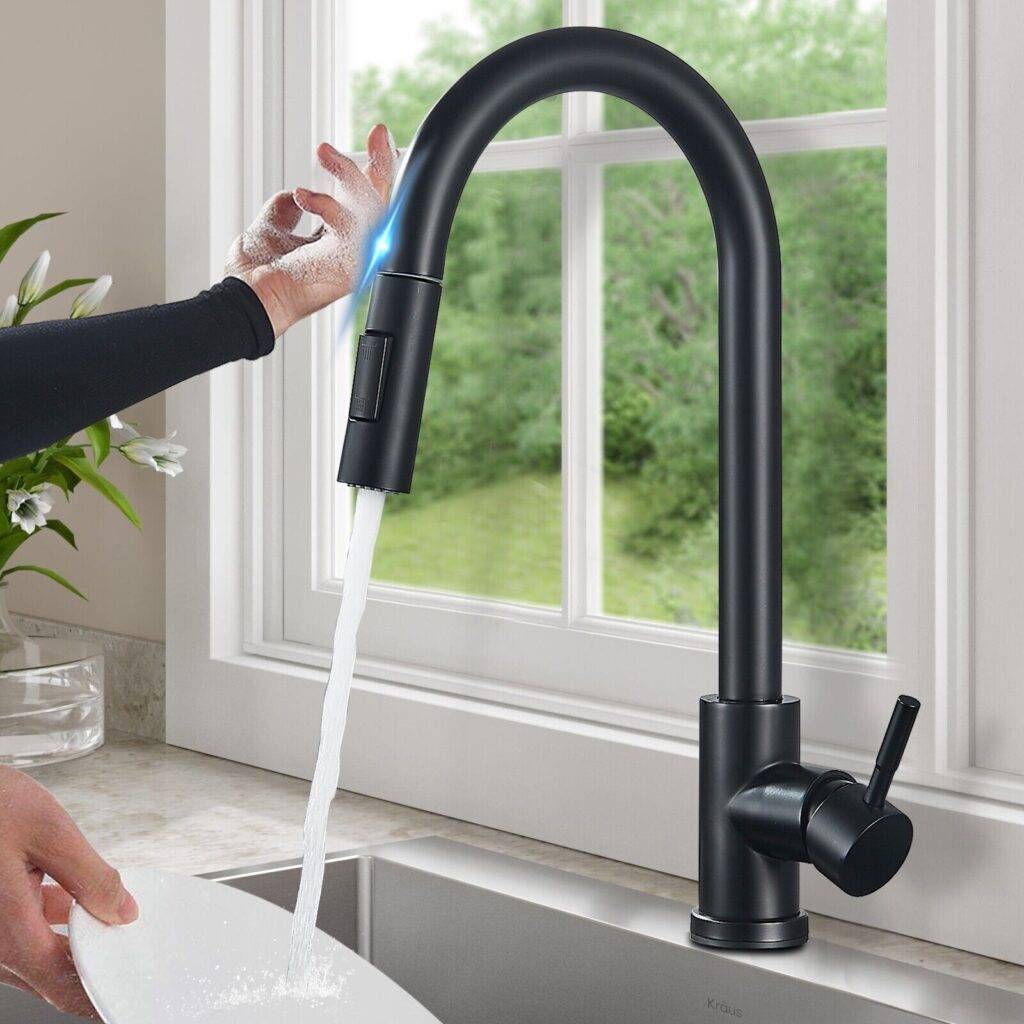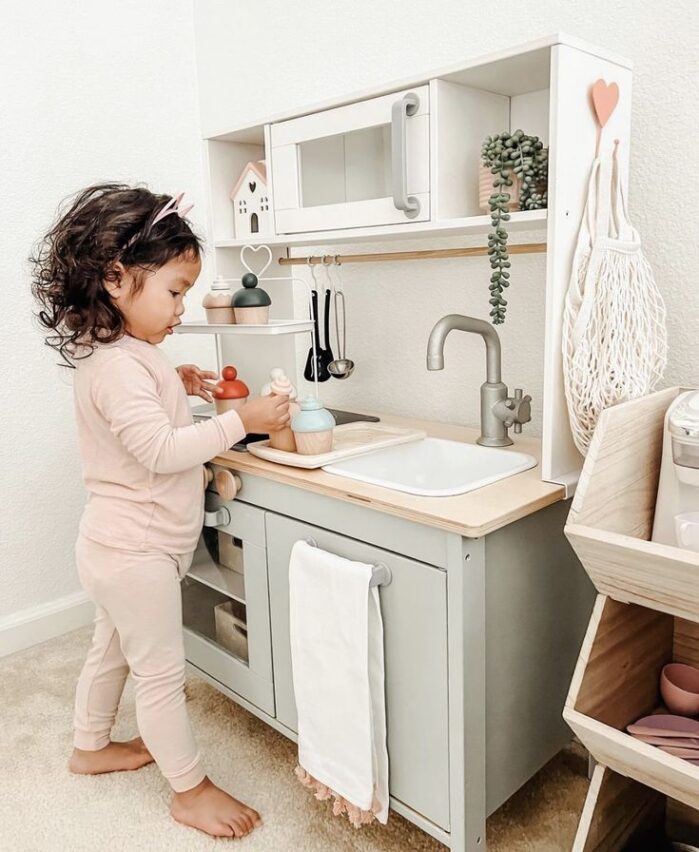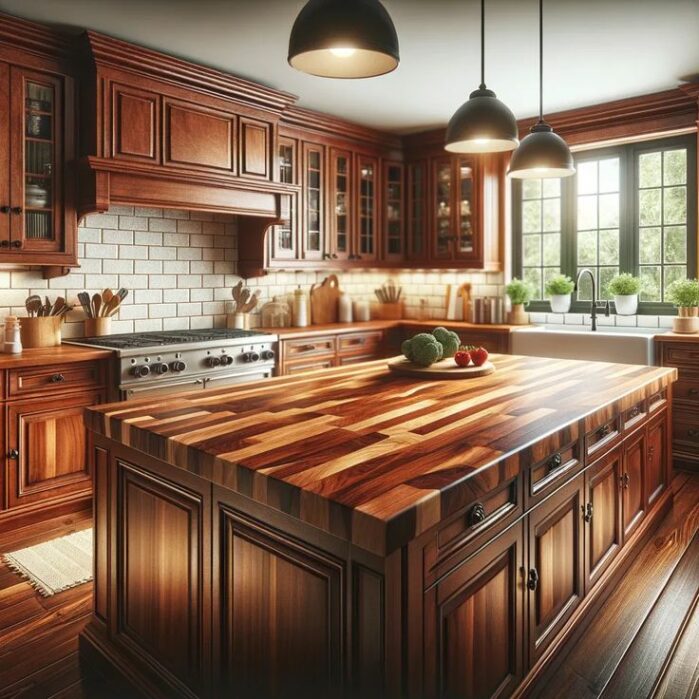Have you ever been cooking with messy hands and wished you didn’t have to touch the faucet? Well, touch kitchen faucets can make that wish come true. These faucets are super handy. Just a simple touch and the water starts flowing. It makes your kitchen tasks a lot easier. These touch kitchen faucet are superb convenient as you don’t need to struggle anymore with dirty hands. It will keep your kitchen clean and its stylist appearance will make your kitchen look sleek and fit in any kitchen decor.
Think about it. Whether you’re a busy parent or someone who loves cooking, a touch kitchen faucet can be a game-changer. Want to know more? Keep reading to discover all the benefits and features of touch kitchen faucets. Plus, we have a handy guide on installation, maintenance, and buying tips.
Trust me, this little upgrade can make a big difference in your kitchen.
What Is A Touch Kitchen Faucet?
A touch kitchen faucet is a type of faucet that allows you to control the water flow by simply tapping or touching the spout or handle. These faucets are equipped with sensors that detect your touch, making it easier and more convenient to turn the water on or off without using your hands, which is particularly useful when your hands are dirty or full.
Ever wished you could turn your kitchen faucet on without getting it dirty? Well, touch kitchen faucets make that possible. You just tap or touch the spout or handle to control the water flow. It’s that simple. These faucets have sensors that detect your touch, making it easy to use them even when your hands are full or messy.
Key Features
- Touch Technology: A sensor on the spout or handle lets you turn the water on or off with a light tap.
- Convenience: Perfect for times when your hands are dirty from handling food or raw meat.
- Hands-Free Control: Some models let you activate the flow by touching any part of the faucet.
- Water Conservation: Helps save water by only running when needed.
- Power Options: Can be powered by batteries or hardwired into your home’s electrical system.
Types of Kitchen Faucet Available
There are various types of touch kitchen faucets to suit different needs and preferences:
- Single Handle Touch Faucets: These have one handle for temperature control. Ideal for modern, minimalist kitchens.
- Double Handle Touch Faucets: Feature separate handles for hot and cold water. Perfect for traditional kitchens.
- Pull-Down Touch Faucets: Include a retractable spray head. Great for washing large pots and pans.
- Commercial Style Touch Faucets: Designed for heavy-duty use. Suitable for home chefs and large families.
- Bar Touch Faucets: Smaller in size. Perfect for bar sinks or secondary kitchen sinks.
Examples of Use
- Cooking and need to wash your hands? Just tap the faucet without making it dirty.
- Washing dishes? Use the sensor to start the water stream with a tap, no need to adjust the faucet manually.
Touch faucets are getting more popular in modern kitchens. Why? Because they’re super convenient and keep things clean.
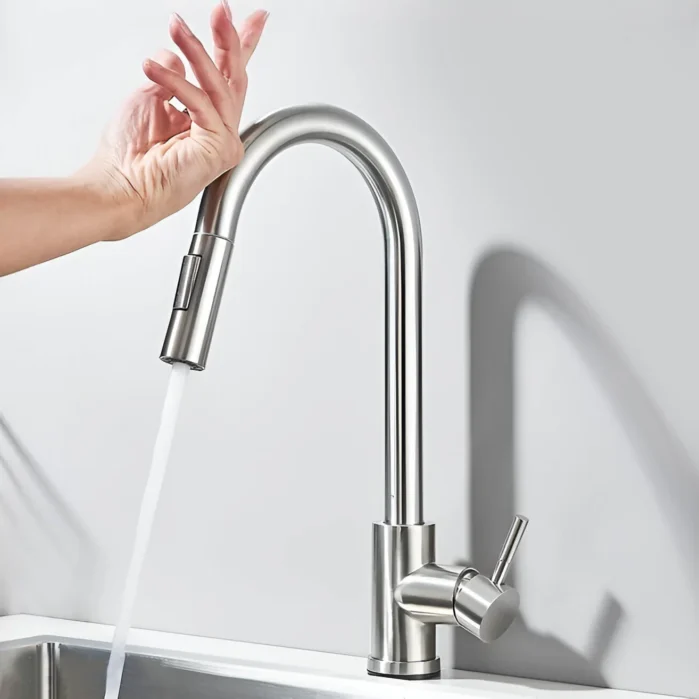
Benefits Of Using Kitchen Touch Faucets
Touch kitchen faucets are becoming a staple in modern homes. They offer many advantages over traditional faucets. From convenience to water efficiency, these faucets make daily kitchen tasks easier and more efficient. Let’s explore the key benefits of touch faucets.
Convenience
Touch faucets provide unmatched convenience in the kitchen. Simply tapping the faucet with your wrist or forearm activates the water flow. This feature is especially useful when your hands are messy from cooking. No need to touch the handle and spread germs.
Here are some key conveniences of touch faucets:
- Easy to Use: Just a light touch turns the water on and off.
- Hygienic: Reduces the spread of bacteria and germs.
- Time-Saving: Quickly rinse ingredients or wash hands without fumbling with handles.
- Modern Design: Sleek and stylish, fits well in any kitchen décor.
Besides these points, touch faucets can also come with other features like:
| Feature | Description |
|---|---|
| Temperature Control | Preset water temperature for ease. |
| LED Indicators | Shows water temperature or battery life. |
| Battery Operated | No need for electrical wiring. |
These features make touch faucets not just convenient but also highly practical for everyday use.
Also Read: 20 Modern Classic Home Decor Idea
Water Efficiency
Touch faucets are not only convenient but also promote water efficiency. They help in reducing water wastage, making them an eco-friendly choice.
Here’s how touch faucets improve water efficiency:
- Automatic Shut-off: The water stops flowing immediately after you remove your hand. This prevents unnecessary water flow.
- Precise Control: Allows for precise control of water flow and temperature, reducing waste.
- Reduced Leakage: Fewer moving parts mean less wear and tear, reducing the risk of leaks.
In addition, touch faucets often come with features like:
| Feature | Description |
|---|---|
| Flow Restrictors | Limits water flow to a set rate. |
| Eco-Friendly Modes | Settings that save water during use. |
These features contribute to significant water savings over time. By using a touch faucet, you help conserve water, which is good for the environment and your utility bills.
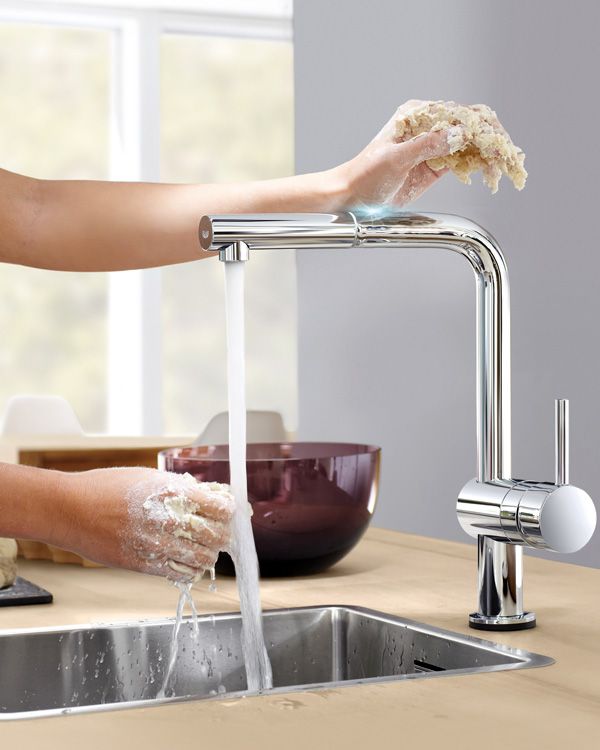
Touch Kitchen Faucet Installation Process
Touch kitchen faucets are a modern addition to any kitchen. They offer convenience and style. Installing a touch kitchen faucet might seem challenging. But with the right guidance, it can be straightforward. This blog post will guide you through the installation process. We’ll discuss both DIY installation and seeking professional help.
DIY Touch Kitchen Faucet Installation
Installing a touch kitchen faucet yourself can be rewarding. It saves money and gives a sense of accomplishment. Here are the steps to follow:
- Gather Tools and Materials: You need a wrench, screwdriver, plumber’s tape, and the faucet kit.
- Turn Off Water Supply: Locate the valves under the sink and turn them off.
- Remove Old Faucet: Use a wrench to disconnect the water lines and remove the old faucet.
- Install New Faucet: Follow the instructions in the kit. Place the faucet through the sink hole.
- Connect Water Lines: Attach the hot and cold water lines to the new faucet.
- Install the Battery Pack: Place the battery pack in a convenient spot under the sink.
- Test the Faucet: Turn on the water supply and check for leaks.
Here’s a quick reference table for the tools and steps:
| Tools | Steps |
|---|---|
| Wrench | Turn off water supply |
| Screwdriver | Remove old faucet |
| Plumber’s tape | Install new faucet |
| Faucet kit | Connect water lines |
Installing a touch kitchen faucet requires some basic plumbing skills. If you are comfortable with DIY projects, this can be a great task to undertake. Ensure you follow each step carefully. This will ensure a smooth installation process.
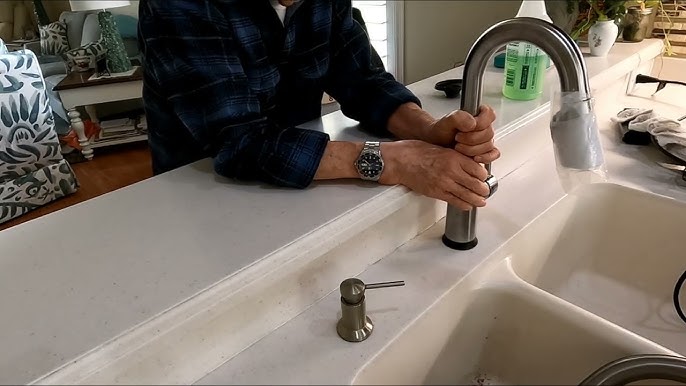
Professional Help
Hiring a professional can make the process easier. Plumbers have the experience and tools needed. Here are the advantages of seeking professional help:
- Expertise: Plumbers have the knowledge to handle any complications.
- Time-Saving: A professional can complete the installation quickly.
- Quality Assurance: Professionals ensure that the installation is done correctly.
- Warranty: Many plumbers offer a warranty on their work.
When hiring a professional, consider these tips:
- Research: Look for reviews and ratings online.
- Get Quotes: Contact several plumbers to compare prices.
- Check Credentials: Ensure the plumber is licensed and insured.
- Ask Questions: Clarify any doubts before they start the work.
Here’s a comparison table of DIY vs. Professional Help:
| DIY Installation | Professional Help |
|---|---|
| Cost-effective | More expensive |
| Time-consuming | Time-saving |
| Sense of accomplishment | Quality assurance |
| Requires basic plumbing skills | Expertise |
Choosing professional help ensures a hassle-free installation. It allows you to relax while the expert handles the task. Consider your budget and comfort level before making a decision.
Also Read: 20 Best Golden Kitchen Ideas for Your Home
Touch Kitchen Faucet Maintenance Tips
Maintaining a touch kitchen faucet can extend its lifespan and keep it looking new. Here are some maintenance tips to help you take care of your faucet effortlessly.
Cleaning Techniques
Regular cleaning is essential for keeping your touch kitchen faucet in top shape. Follow these simple steps:
- Daily Wipe Down: Use a soft cloth dampened with water to wipe the faucet. This prevents buildup of grime and water spots.
- Soap and Water: For a deeper clean, mix a mild soap with warm water. Use a soft cloth or sponge to clean the faucet. Rinse thoroughly and dry with a clean towel.
- Vinegar Solution: For tougher stains, use a solution of equal parts water and white vinegar. Apply the solution with a soft cloth and gently scrub the stained areas. Rinse well and dry.
- Avoid Harsh Chemicals: Do not use abrasive cleaners or pads. They can damage the finish and touch sensors.
| Cleaning Frequency | Method |
|---|---|
| Daily | Wipe with a damp cloth |
| Weekly | Soap and water |
| Monthly | Vinegar solution |
Troubleshooting Common Issues
Even with regular maintenance, you may encounter some issues with your touch kitchen faucet. Here are solutions to common problems:
- Faucet Not Responding to Touch:
- Check the power source. Ensure the batteries are charged or the adapter is plugged in.
- Clean the touch sensors with a soft cloth. Dirt can interfere with the sensors.
- Reset the faucet by turning off the water supply and disconnecting the power for a few minutes.
- Low Water Pressure:
- Check the aerator. Unscrew it and clean any debris.
- Inspect the supply lines for kinks or blockages.
- Leaking Faucet:
- Tighten any loose connections with a wrench.
- Replace worn-out washers or O-rings.
- Consult the user manual for specific instructions on replacing parts.
If issues persist, consult a professional plumber. Regular checks and prompt fixes will ensure your touch kitchen faucet operates smoothly.
Choosing The Right Touch Kitchen Faucet
Choosing the right touch kitchen faucet can make a big difference in your kitchen. With many options available, it’s essential to find a faucet that suits your style and budget. This guide will help you navigate through the choices and make an informed decision.
Style Considerations
When selecting a touch kitchen faucet, style is a crucial factor. You want a faucet that complements your kitchen’s look. Here are some points to consider:
- Finish: Choose from stainless steel, chrome, matte black, or brushed nickel. Match the finish with other kitchen fixtures.
- Design: Faucets come in various designs like traditional, modern, and transitional. Pick a design that aligns with your kitchen’s theme.
- Spout Height and Reach: A higher spout provides more room for washing large pots. Check the reach to ensure it fits your sink size.
- Handle Style: Some faucets have single handles, while others have double handles. Single handles are easier to use, especially with wet or soapy hands.
Here is a table to help you compare different styles:
| Feature | Traditional | Modern | Transitional |
|---|---|---|---|
| Finish | Brushed Nickel, Bronze | Chrome, Matte Black | Stainless Steel, Chrome |
| Design | Curved Lines | Sleek, Minimalist | Blend of Traditional and Modern |
| Spout Height | Medium to High | High | Medium |
Budget Consideration
Budget is a significant consideration when choosing a touch kitchen faucet. You want a faucet that fits your needs without breaking the bank. Here are some budget factors to keep in mind:
- Price Range: Touch kitchen faucets can range from $100 to $600. Decide on a budget before you start shopping.
- Brand: Some brands are known for quality and durability, such as Delta, Moen, and Kohler. These brands may cost more but offer better longevity.
- Features: More features can mean a higher price. Decide which features are essential, like pull-down spouts or multi-function spray heads.
- Installation Costs: Don’t forget to factor in the cost of professional installation if you can’t do it yourself. This can add $50 to $200 to your budget.
Here’s a table showing an estimated budget breakdown:
| Item | Low Range | High Range |
|---|---|---|
| Faucet | $100 | $600 |
| Installation | $50 | $200 |
| Total | $150 | $800 |
Popular Brands of Touch Kitchen Faucets
Touch kitchen faucets have gained popularity for their convenience and style. With a simple touch, you can turn the water on and off, making kitchen tasks easier and more hygienic. Many brands offer these faucets, each with unique features and designs. Let’s explore some popular brands known for their quality and innovation.
Top Manufacturers
Several manufacturers stand out in the touch kitchen faucet market. These brands are known for their reliability, innovative features, and stylish designs. Here are some of the top manufacturers:
- Delta Faucet: Delta offers a range of touch kitchen faucets with their patented Touch2O® Technology. This technology allows you to start and stop the flow of water with a simple touch anywhere on the spout or handle. Delta’s faucets are known for their durability and sleek designs.
- Moen: Moen‘s touch kitchen faucets feature their MotionSense™ Technology. This allows for hands-free operation through sensors that detect your hand movements. Moen is known for its modern designs and reliable performance.
- Kohler: Kohler offers touchless and touch-on kitchen faucets with their Response® Technology. These faucets respond to a light touch for water control, offering both convenience and efficiency. Kohler is praised for its high-quality materials and elegant designs.
- American Standard: American Standard’s Selectronic® faucets are popular for their ease of use and smart features. They offer touch and touchless options, ensuring a clean and convenient kitchen experience. Their faucets are known for being both functional and stylish.
Customer Reviews
Customer reviews provide valuable insights into the performance and satisfaction of touch kitchen faucets. Here are some common themes from user feedback:
- Ease of Use: Many users appreciate the convenience of touch activation. They find it especially useful when their hands are dirty or full.
- Hygiene: Touch faucets are praised for their hygienic benefits. Users like that they can avoid spreading germs by not having to touch the handles.
- Design: Customers often highlight the sleek and modern designs of these faucets. They find them to be a stylish addition to their kitchens.
- Installation: Reviews mention that installation can be straightforward with clear instructions. Some users, though, suggest professional installation for best results.
Below is a table summarizing some common customer ratings for the top brands:
| Brand | Ease of Use | Hygiene | Design | Installation |
|---|---|---|---|---|
| Delta Faucet | 4.8/5 | 4.7/5 | 4.9/5 | 4.5/5 |
| Moen | 4.6/5 | 4.8/5 | 4.7/5 | 4.4/5 |
| Kohler | 4.7/5 | 4.6/5 | 4.8/5 | 4.3/5 |
| American Standard | 4.5/5 | 4.5/5 | 4.6/5 | 4.2/5 |
Comparing Touch Vs. Traditional Faucets
Touch kitchen faucets are becoming popular in modern kitchens. These faucets have advanced technology, allowing you to turn them on or off with a simple touch. Comparing touch faucets to traditional faucets helps homeowners decide which option best suits their needs. This blog post explores the differences in functionality and cost between touch and traditional faucets.
Functionality Differences
Both touch and traditional faucets aim to provide water efficiently, but their functionalities differ significantly. Here are some key differences:
- Activation Method: Traditional faucets use handles or knobs to control water flow. Touch faucets require a light touch anywhere on the spout or handle to activate.
- Hygiene: Touch faucets promote better hygiene. You can turn them on with your wrist or elbow, reducing contact with germs, especially after handling raw food.
- Water Conservation: Touch faucets often have automatic shut-off features. This feature helps save water if you forget to turn off the tap.
- Convenience: With a touch faucet, you can quickly turn on the water even if your hands are full or dirty. Traditional faucets require free hands to operate.
| Feature | Touch Faucets | Traditional Faucets |
|---|---|---|
| Activation | Touch Sensitive | Manual Handles/Knobs |
| Hygiene | High (less contact) | Moderate (more contact) |
| Water Conservation | Automatic Shut-off | Manual Shut-off |
| Convenience | High (hands-free) | Moderate (hands needed) |
Cost Analysis of Kitchen Touch Faucet
When comparing the cost of Kitchen touch faucets to traditional faucets, several factors come into play. Here is a breakdown:
- Initial Purchase Price: Touch faucets are generally more expensive than traditional faucets. Prices for touch faucets can range from $200 to $600, while traditional faucets range from $50 to $200.
- Installation Costs: Installing a touch faucet may require professional help, adding to the cost. Traditional faucets are usually easier to install and may not need professional assistance.
- Maintenance: Touch faucets may require more maintenance due to their electronic components. Traditional faucets have fewer parts and are easier to repair.
- Water Savings: Touch faucets can save money on water bills over time due to their automatic shut-off feature. Traditional faucets rely on manual operation, which may lead to more water waste.
| Cost Factor | Touch Faucets | Traditional Faucets |
|---|---|---|
| Initial Price | $200 – $600 | $50 – $200 |
| Installation | Higher (professional help) | Lower (DIY possible) |
| Maintenance | Higher (electronic parts) | Lower (fewer parts) |
| Water Savings | Potential savings | Depends on usage |
Understanding these differences helps you choose the right faucet for your kitchen based on functionality and cost.
Future Trends of Touch Kitchen Faucets
Touch kitchen faucets have become a popular choice in modern kitchens. They offer convenience and style. But what does the future hold for these innovative fixtures? Let’s explore some exciting future trends that will shape the next generation of touch kitchen faucets.
Smart Technology Integration
One of the most promising trends in touch kitchen faucets is smart technology integration. As homes become smarter, so do our kitchen fixtures. Future touch kitchen faucets will likely feature:
- Voice Activation: Control your faucet with simple voice commands.
- App Control: Use a smartphone app to adjust water temperature and flow.
- Automation: Set schedules for your faucet to turn on and off automatically.
Imagine asking your faucet to fill a pot with water while you chop vegetables. Or adjusting the water temperature with a swipe on your phone. These features will make cooking and cleaning more efficient.
Smart integration will enhance convenience and give users more control. It will also pave the way for more energy-efficient use of water.
Sustainability Efforts
Another key trend is the focus on sustainability. Environmental concerns are driving innovations in touch kitchen faucets. Future designs will likely emphasize:
- Water Conservation: Faucets that reduce water usage without compromising performance.
- Eco-Friendly Materials: Use of recycled and sustainable materials in manufacturing.
- Energy Efficiency: Faucets that use less energy to operate.
Water conservation is critical. Future faucets may have sensors to detect leaks and alert homeowners. They might also offer precise water flow control, ensuring no water is wasted. These efforts will make touch kitchen faucets more eco-friendly. They will help reduce the environmental impact of our daily activities.
Frequently Asked Questions
How Does A Touch Kitchen Faucet Work?
A touch kitchen faucet works using sensors. These sensors detect touch to start and stop water flow. It offers convenience, hygiene, and water-saving benefits.
Are Touch Kitchen Faucets Reliable?
Yes, touch kitchen faucets are reliable. They use advanced sensors and technology. They are designed for long-term use and durability.
Can I Install A Touch Faucet Myself?
Yes, you can install a touch faucet yourself. It typically comes with detailed instructions. Basic plumbing knowledge is beneficial.
Do Touch Kitchen Faucets Need Batteries?
Yes, touch kitchen faucets need batteries. They power the sensors and electronics. Battery life usually lasts one to two years.
Conclusion
A touch kitchen faucet adds ease to your daily tasks. It offers convenience and hygiene. No more messy handles. The sleek design fits any kitchen style. It saves water and time. Perfect for busy households. Investing in a touch faucet is smart.
Upgrade your kitchen and enjoy the benefits. Your cooking and cleaning will feel effortless. Make your life easier with this modern innovation.

